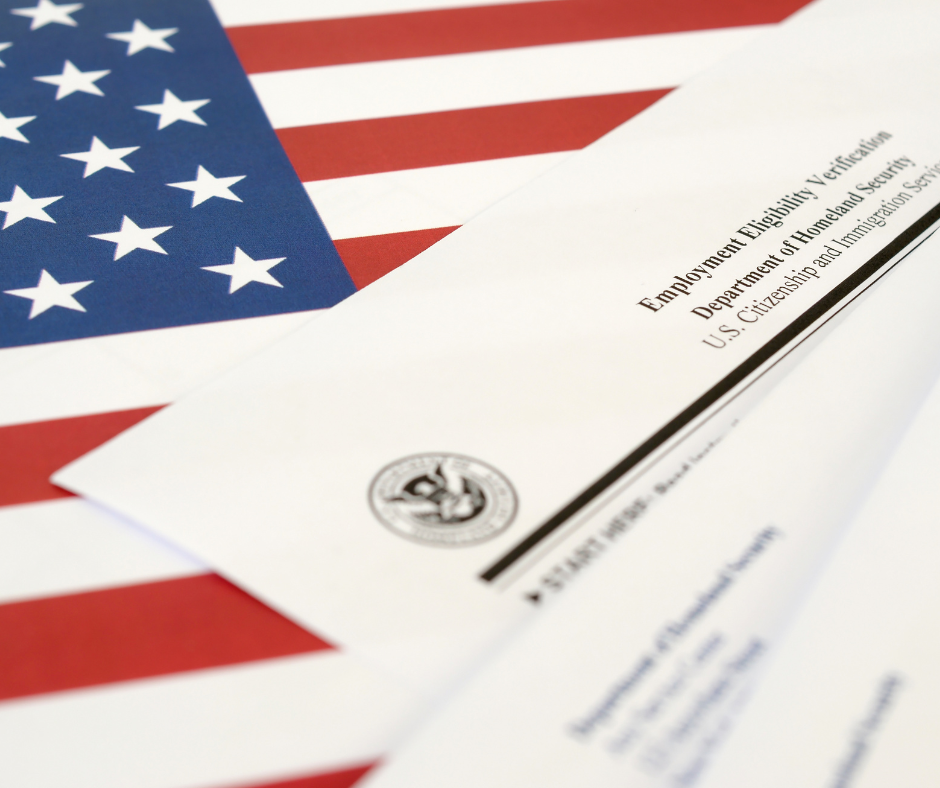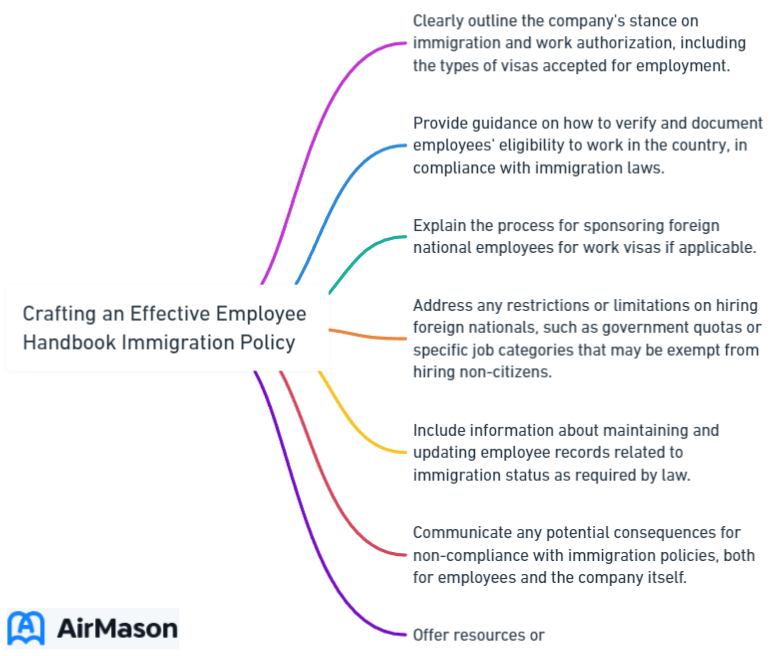
In today’s globalized world, businesses often find themselves employing foreign nationals to tap into diverse skill sets and expertise. With this comes the responsibility of understanding and incorporating immigration policies into your employee handbooks. A well-crafted immigration policy can not only ensure compliance with the law, but also provide a supportive environment for foreign national employees. So, how do you create an effective employee handbook immigration policy that addresses the complexities of the ever-changing immigration landscape? Let’s dive in!
Key Takeaways
- Understand immigration policies and their impact on the workplace
- Incorporate immigration policies into your employee handbook to ensure compliance with federal laws
- Stay informed of policy changes, provide resources for employees, and seek legal counsel when necessary
Understanding Immigration Policies and Their Impact on the Workplace
Immigration policies significantly influence the workplace, given that employers shoulder the responsibility of sponsoring foreign nationals for employment and complying with federal immigration laws and regulations. A clear and comprehensive company policy for immigration in your employee handbook ensures that all parties involved understand their rights and obligations, eliminating potential claims of unequal or unjust treatment. Moreover, it sets expectations and guidelines for the immigration sponsorship process, which may include the green card process, visa sponsorship, and adjustment of status for foreign national employees.
Navigating the myriad of federal immigration laws and regulations can be challenging for employers. This is where understanding immigration status categories, such as nonimmigrant visas, lawful permanent residency, and citizenship, becomes critical. Recognizing these categories and their implications enables employers to make well-informed decisions regarding the hiring of foreign national employees and the management of their immigration matters. To ensure compliance with federal immigration laws, employers may seek assistance from citizenship and immigration services.
Federal Immigration Laws and Regulations
One of the most important aspects of managing foreign national employees is ensuring compliance with federal immigration laws and regulations. Key among these are the anti-discrimination provisions of the Immigration and Nationality Act (INA) and the provisions of the United States Department of Homeland Security (DHS). Employers must be aware of these regulations to avoid potential penalties and ensure fair treatment of their foreign national employees, regardless of their immigration status.
Staying compliant requires employers to consistently review and refresh their policies, seek advice from legal counsel, and confront any discrimination or harassment related to immigration matters. Other legal requirements, including federal, state, and local laws, that may impact the recruitment and employment processes, such as the green card process for foreign nationals, should also be taken into account.

Immigration Status Categories
Immigration status categories help employers understand the different types of foreign national employees they may encounter. For example, the employment-based immigrant categories include:
- EB-1: individuals with extraordinary ability
- EB-2: professionals with advanced degrees or exceptional ability
- EB-3: skilled workers or professionals with specific education or experience requirements
These categories help employers navigate the immigration process and determine the appropriate visa options for their employees.
Nonimmigrants, on the other hand, are individuals who are temporarily authorized to work in the United States, such as those on H-1B, L-1, or TN visas. Employment eligibility for these individuals depends on their specific visa type and the authorization provided by the Department of Homeland Security.
Comprehending these immigration status categories is vital for employers during the hiring and retention of foreign national employees.
Incorporating Immigration Policies into Your Employee Handbook
Incorporating immigration policies into your employee handbook provides a clear framework for managing foreign national employees and ensuring compliance with immigration laws. This includes guidelines for sponsorship, labor market requirements, and procedures for obtaining necessary documentation. A well-defined immigration policy can also help employers avoid discrimination claims under the INA and streamline the hiring and sponsorship process for both employers and foreign national employees.
The incorporation of immigration policies into your employee handbook should involve:
- Defining the company’s immigration policy
- Ensuring compliance with immigration laws
- Supplying resources and support
- Preserving confidentiality
- Training managers and HR staff
This comprehensive approach ensures that your organization stays compliant with the law and creates a supportive environment for foreign national employees.
Compliance with Anti-Discrimination Laws
It is vital to adhere to anti-discrimination laws during the incorporation of immigration policies into your employee handbook. The Immigration and Nationality Act (INA) prohibits employers from discriminating against individuals based on their national origin or citizenship status. Employers must also consider other relevant laws, such as Title VII of the Civil Rights Act of 1964, the Americans with Disabilities Act (ADA), and the Age Discrimination in Employment Act (ADEA).
To ensure compliance with these laws, employers should:
- Have their immigration policies written in a non-discriminatory manner
- Provide training to staff on proper implementation of the policy
- Review their policies regularly to ensure they are up-to-date with any changes in the law
Failure to comply with anti-discrimination laws may result in civil and criminal penalties, including monetary fines and/or incarceration, as well as private lawsuits from individuals who have experienced discrimination.
Streamlining Hiring and Sponsorship Processes
A clear immigration policy can simplify the hiring and sponsorship process for both employers and foreign national employees. Here are some steps to optimize the process.
- Establish job requirements and qualifications.
- Incorporate technology and automation to streamline the application process.
- Implement a standardized interview process to ensure fairness and consistency.
- Ensure timely communication with applicants to keep them informed of their status.
By following these steps, employers can optimize their hiring and sponsorship processes.
Streamlining these processes allows employers to:
- Minimize the time and resources invested in hiring and sponsorship
- Adopt a more efficient and cost-effective approach
- Increase employee satisfaction and retention
- Provide foreign national employees with a clear understanding of their employment eligibility and sponsorship expectations.
If you need help with developing and implementing effective organizational policies, read our article on policy outline example, as it serves as a roadmap for creating comprehensive and coherent policies that align with an organization’s goals and values while providing clear guidance to employees and stakeholders.
Sponsorship Guidelines for Employers
Sponsoring foreign nationals for employment involves several key considerations, such as:
- Assessing eligibility
- Acquiring necessary documentation, including labor certification
- Complying with labor market requirements
- Providing a job offer and contract
- Adhering to immigration laws
- Keeping records
Grasping these aspects is vital for employers in navigating the intricate world of immigration sponsorship.
In the following subsections, we will delve into the specific steps involved in sponsoring foreign national employees for permanent residence (Green Card) and temporary work visas. This information will help employers develop a comprehensive understanding of the sponsorship process and guide them in making informed decisions when hiring and retaining foreign national employees.
Green Card Sponsorship Process
The Green Card sponsorship process can be a complex and time-consuming endeavor for both employers and foreign national employees. When sponsoring an employee for permanent residence, employers must first assess the employee’s eligibility, which includes meeting job qualifications, not being inadmissible to the United States, and having a genuine intent to work for the employer. Employers are also responsible for bearing the expenses related to the sponsorship, such as filing fees and costs associated with obtaining an immigrant visa for the foreign national employee.
The step-by-step procedure for sponsoring a foreign national to become a lawful permanent resident involves multiple levels of approval, from the hiring unit to the Dean, Vice-President, and Provost. The process includes obtaining necessary information and documentation, conducting an initial review for any issues, and assigning the case to external counsel. Once the signed petition is returned, external counsel submits the documents to the applicable government agency for processing and provides updates to the employer and employee until permanent residency is granted.

Temporary Work Visas
In addition to permanent residence sponsorship, employers may also sponsor foreign national employees for temporary work visas, such as H-1B, L-1, and TN visas. The procedure for obtaining these visas varies depending on the country and specific visa type, but generally includes the following steps:
- Identifying the appropriate visa type
- Employer sponsorship
- Collecting necessary documents
- Completing the application form
- Paying the visa fees
- Submitting the application
- Attending an interview (if necessary)
- Taking a medical examination (if necessary)
- Waiting for a decision.
Employer sponsorship plays a significant role in the temporary work visa process, as it involves the employer filing the necessary paperwork and providing evidence of the employee’s qualifications and job offer. By understanding the different temporary work visa options and requirements, employers can better navigate the complexities of the sponsorship process and support their foreign national employees throughout their employment journey.
Managing and Retaining Foreign National Employees
Maintaining a diverse and inclusive workforce necessitates effective management and retention of foreign national employees. By incorporating comprehensive immigration policies into your employee handbook, employers can provide a supportive environment for foreign national employees and ensure compliance with employment eligibility requirements.
In addition, employers can support career growth and employee retention by:
- Offering professional development and training opportunities
- Providing clear career paths and advancement opportunities
- Recognizing and rewarding accomplishments.
In the following subsections, we will discuss best practices for verifying employment eligibility through Form I-9 and E-Verify, as well as strategies for supporting the professional growth and retention of foreign national employees, including obtaining permanent employment certification. These guidelines will help employers navigate the challenges of managing a diverse workforce and ensure a positive experience for their foreign national employees.
Employment Eligibility Verification
Employment eligibility verification is a critical aspect of managing foreign national employees, as it ensures adherence to federal immigration laws and regulations. Employers are required to complete Form I-9 for all employees, which verifies an individual’s identity and employment authorization in the United States. In some cases, a foreign national may need to present an employment authorization document as part of this process. In addition to Form I-9, employers may also choose to use E-Verify, an internet-based system that enables employers to verify the eligibility of their employees to work in the United States.
To maintain compliance with immigration laws, employers should:
- Establish a system for verifying employee eligibility
- Ensure consistency in the process
- Preserve records
- Provide training and compliance
- Perform self-audits
- Consult legal counsel when necessary
By adhering to these best practices, employers can reduce the risk of non-compliance and create a more secure and supportive environment for their foreign national employees.
Supporting Career Growth and Employee Retention
Supporting the career growth and retention of foreign national employees can significantly contribute to a company’s success. By offering professional development and training opportunities, such as training programs, online learning resources, and conferences, employers can help their foreign national employees acquire new skills and advance in their careers.
Additionally, employers should provide:
- Clear career paths and advancement opportunities
- Job descriptions and career ladders
- Feedback and performance evaluations
- Mentorship and coaching programs
By recognizing and rewarding accomplishments, employers can further motivate their foreign national employees and foster a sense of loyalty and commitment to the organization.
Navigating Immigration Policy Changes and Challenges
Immigration policies are subject to change, and employers must be prepared to adapt their employee handbook immigration policy accordingly. A flexible immigration sponsorship policy helps both the company and the foreign national worker. It enables a healthy balance between business-side considerations and individual requests and needs.
To effectively manage immigration policy changes and challenges, employers should:
- Stay informed of immigration policy changes
- Seek professional guidance
- Ensure compliance
- Devise contingency plans
- Participate in advocacy initiatives
- Offer support to employees
By following these steps, employers can navigate immigration policy changes and ensure a smooth transition for their employees.
In the following subsections, we will explore strategies for staying informed on policy changes and handling immigration-related challenges, such as delays in visa processing or changes to work authorization. These guidelines will help employers adapt their employee handbook immigration policy and maintain a supportive environment for their foreign national employees.
Staying Informed on Policy Changes
Keeping abreast of immigration policy changes is vital for employers to assure legal compliance and protect their employees. Employers can stay up-to-date on changes by:
- Subscribing to government newsletters and updates
- Following reliable news sources
- Joining professional organizations and advocacy groups
- Attending conferences and seminars
- Engaging with immigration attorneys and experts
- Utilizing online resources
By staying informed, employers can make necessary adjustments to their immigration policies and procedures, ensuring compliance with current regulations and addressing any arising issues. This proactive approach can help employers maintain a supportive environment for their foreign national employees and mitigate potential risks associated with immigration policy changes.
Handling Immigration-Related Challenges
Immigration-related challenges can surface unexpectedly, requiring employers to be equipped to manage them effectively. A comprehensive immigration policy that includes provisions for addressing challenges, such as delays in visa processing or changes to work authorization, can help employers navigate these issues and provide support to their foreign national employees through reliable immigration services.
To handle immigration-related challenges, employers should:
- Provide employees with appropriate channels to seek guidance and ask questions about immigration matters
- Ensure that managers are equipped to respond to these inquiries
- Consult legal counsel when necessary.
Additionally, cultivating a welcoming atmosphere and providing resources for employees to understand their rights and obligations can foster a supportive environment and help alleviate some of the challenges associated with immigration-related matters.
Summary
In conclusion, crafting an effective employee handbook immigration policy is essential for employers to manage and retain foreign national employees, ensure compliance with immigration laws, and navigate the complexities of the immigration landscape. By understanding the intricacies of immigration policies and regulations, incorporating these policies into employee handbooks, and providing support and resources to foreign national employees, employers can create a diverse and inclusive workforce that thrives in today’s globalized world.
Frequently Asked Questions
What is the immigration policy of a company?
Company’s immigration policy involves consultation with the in-house and external immigration team to determine which visa category will be sponsored, and this process may be stopped due to business needs or employee performance.
The policy ensures legally compliant guidelines and processes for recruiting and hiring foreign national employees.
What policies should go into an employee handbook?
An employee handbook should include your business’s policies, such as a Code of Conduct, Communications policy, Nondiscrimination policy, Compensation and Benefits policy, New Hire and Separation policy, Acknowledgment of Receipt, and legal obligations such as Notice and Disclaimer, Employment At-Will policy, Equal Opportunity Statement and Anti-Harassment Statement, Work Authorization, Policy on Employment Classification, Overtime, Leaves of Absence, and Parental Leave.
These policies should be clearly outlined and explained in the handbook, so that employees understand their rights and responsibilities. Additionally, the handbook should include any other relevant information, such as company history, mission statement, and contact information.
Are employers allowed to ask about immigration status?
No, employers should not inquire about an applicant’s immigration status or ask questions related to citizenship. All applicants must be given the same equal opportunity when applying for a job, regardless of immigration or citizenship status.
Employers may only request documents related to legal work authorization in the United States, and they cannot ask questions based on protected characteristics.
What are the 7 typical employee handbook categories?
Employee handbooks typically include Employment Basics, Workplace Policies, Code of Conduct, Compensation and Development, Benefits and Perks, Working Hours, PTO and Vacation, and Employee Resignation and Termination.
What are some steps for implementing a new company policy?
Implementing company policies effectively involves a series of well-defined steps to ensure that the policies are understood, followed, and consistently applied across the organization. Here are the key steps in the process of company policy implementation:
- Policy Development
- Management Approval
- Company policy sign off
- Communication and Training
- Compliance Monitoring
- Feedback and Revision
What is the importance of incorporating immigration policies into an employee handbook?
Incorporating immigration policies into an employee handbook ensures compliance with immigration laws and provides a supportive environment for foreign national employees, helping businesses stay compliant while creating a positive work culture.
Immigration policies can help businesses stay compliant with immigration laws, while also creating a positive work culture for foreign national employees. This can be achieved by including immigration policies in the employee handbook. Doing so will ensure that all employees are aware of the company’s immigration policies and will ensure that all employees are aware of the company’s immigration policies.


